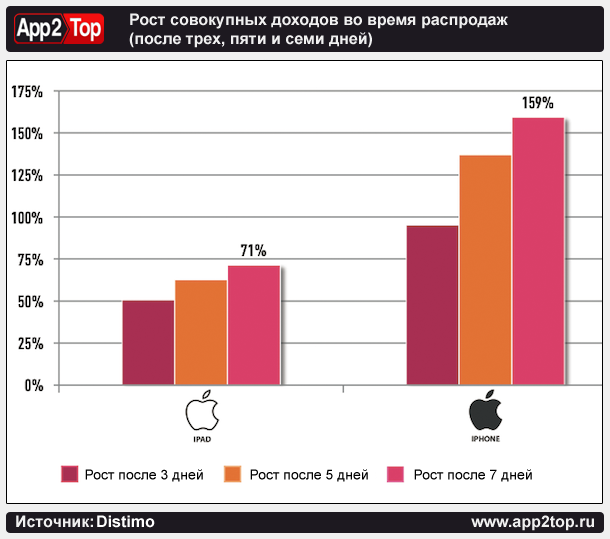The decline in the cost of iPhone applications led to a 95% increase in their total revenues during the Christmas season in the first three days of sales. iPad programs were less sensitive to discounts. Income from them after lowering the price tag increased by only 51%.
Distimo writes about this in its latest study. According to the company, the longer the promotion lasted, the higher the revenue from the application became. Seven days after the sales began, iPhone app revenue increased by 159%, and iPad app revenue by 71%. Moreover, the growth was shown by income not only from one-time purchases, but also from IAP.

After the prices returned to their previous positions, iPhone app downloads fell by 46% in five days, and iPad app downloads by 57%. That is, it is clear that discounts have had an impact not only on app revenue, but also on the number of downloads. Which, in principle, is logical. The decrease in the cost of iPhone applications in five days led to a 1665% increase in their downloads, the sale of iPad programs led to an 871% increase in downloads.
Based on the collected data, Distimo calculated the coefficient of elasticity, in this case, a measure of the sensitivity of income from the application to changes in its value. So it turned out that reducing the cost of the application by 1% leads to an increase in revenue from it by 1.2% in the five-day perspective. The elasticity of the iPad price is -0.7%: a 1% discount increases the app’s profit by 0.7%.
These data are true in relation to December last year, so they are not absolute.
In December, according to the Danish company, the cost of 850 iPhone apps and 930 iPad apps fell. The range of discounts in most cases was quite wide: from $ 1 to $ 3.

According to Distimo, it is not worth waiting for such a noticeable increase in sales and downloads during the sale on Android, although a positive effect is also observed.
The report included only applications from the top 400 from the 10 largest apple stores in the world.
